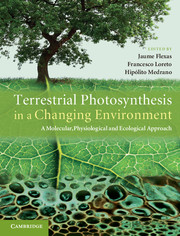 Terrestrial Photosynthesis in a Changing Environment
Terrestrial Photosynthesis in a Changing Environment Book contents
- Frontmatter
- Contents
- List of contributors
- Preface
- Acknowledgements
- List of abbreviations
- 1 Terrestrial photosynthesis in a changing environment
- Part I Photosynthesis
- Part II Measuring photosynthesis
- Part III Photosynthetic response to single environmental factors
- Part IV Photosynthesis in time
- Part V Photosynthesis in space
- 26 Whole-plant photosynthesis: potentials, limitations and physiological and structural controls
- 27 Ecophysiology of photosynthesis in the tropics
- 28 Ecophysiology of photosynthesis in desert ecosystems
- 29 Ecophysiology of photosynthesis in semi-arid environments
- 30 Ecophysiology of photosynthesis in temperate forests
- 31 Ecophysiology of photosynthesis in boreal, arctic and alpine ecosystems
- 32 Crop photosynthesis
- Part VI Photosynthesis in a global context
- References
- Index
32 - Crop photosynthesis
Published online by Cambridge University Press: 05 March 2013
- Frontmatter
- Contents
- List of contributors
- Preface
- Acknowledgements
- List of abbreviations
- 1 Terrestrial photosynthesis in a changing environment
- Part I Photosynthesis
- Part II Measuring photosynthesis
- Part III Photosynthetic response to single environmental factors
- Part IV Photosynthesis in time
- Part V Photosynthesis in space
- 26 Whole-plant photosynthesis: potentials, limitations and physiological and structural controls
- 27 Ecophysiology of photosynthesis in the tropics
- 28 Ecophysiology of photosynthesis in desert ecosystems
- 29 Ecophysiology of photosynthesis in semi-arid environments
- 30 Ecophysiology of photosynthesis in temperate forests
- 31 Ecophysiology of photosynthesis in boreal, arctic and alpine ecosystems
- 32 Crop photosynthesis
- Part VI Photosynthesis in a global context
- References
- Index
Summary
Crop Photosynthesis
Human societies are dependent upon the productivity of domesticated plant species, including cereals, oilseeds, pulse crops, fruits, vegetables and nuts consumed directly by people; also domesticated animals kept for milk, egg and meat production are reared on feed derived from plants, including grains and leguminous and non-leguminous forage species. Thus, the worldwide availability of calories, protein, dietary fats and other nutrients for human sustenance depends directly on the growth, and therefore the photosynthetic activity, of crops. Accordingly, carbon assimilation of crop species has been extensively studied as a matter of practical importance. Most recently, the expanding use of agricultural crops and crop residues as feedstocks for biofuel production has rejuvenated interest in the potential for increased fixation of atmospheric carbon and capture of solar energy by crop species and agronomic systems (Brown et al., 2000; Heaton et al., 2004). All together, the importance of crop productivity has led in recent years to increased efforts for improving crop photosynthesis by means of mutation discovery and/or transgenic (Parry et al., 2009; Mittler and Blumwald, 2010; see Chapter 13) or epigenetic (Hauben et al., 2009; Mittler and Blumwald, 2010) approaches.
The most relevant spatial scale for the study of crop photosynthesis is often the whole-canopy (plant-community) scale. Communities of crop plants are unique in that they tend to be extremely uniform, usually consisting of a single species (indeed, most often a single genotype), with all members closely synchronised in terms of their phenological development. This unusual uniformity greatly simplifies the study and modelling of crop photosynthesis and growth at the community scale, and has allowed the relevant theory to advance very quickly in comparison with other areas of plant ecology. For example, because crop canopies are spatially quite uniform, they can for some purposes be treated as homogeneous surfaces. This allows photosynthesis of crop canopies to be characterised using theoretical approaches similar to those used for single leaves, quantifying such aspects as light absorption and gas exchange in one dimension (i.e., fluxes per unit area, in this case ground area).
- Type
- Chapter
- Information
- Terrestrial Photosynthesis in a Changing EnvironmentA Molecular, Physiological, and Ecological Approach, pp. 506 - 520Publisher: Cambridge University PressPrint publication year: 2012
- 1
- Cited by


